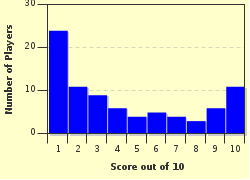Quiz Answer Key and Fun Facts
1. According to this episode, what is the largest number in existence?
2. What does the "H" in "MATHS" stand for?
3. According to this episode, what is 1 + 10?
4. Which of these is NOT given as a way in which maths can be used in everyday life?
5. Try this problem from the episode:
"Jean is shorter than Brutus, but taller than Imhotep. Imhotep is taller than Jean, but shorter than Lord Scotland. Lord Scotland is twice the height of Jean and Brutus combined, but only a tenth of the height of Millsy. Millsy is at a constant height of [x-y].
If Jean stands exactly one nautical mile away from Lord Scotland, how tall is Imhotep?"
6. What is the name of the following equation: "n^2 + 9 + 9"?
7. When is the contest held to determine a name for the mysterious "uniformly curved line"?
8. By how much were the eight ladies short when attempting to take the bus home from buying their spiders?
9. Which of these is NOT stored in a pencil case?
10. To do the problems featured in the episode, your calculator must be set to "Maths". Which of these modes could you NOT alternately set it to?
Source: Author
daBomb619
This quiz was reviewed by FunTrivia editor
ladymacb29 before going online.
Any errors found in FunTrivia content are routinely corrected through our feedback system.


